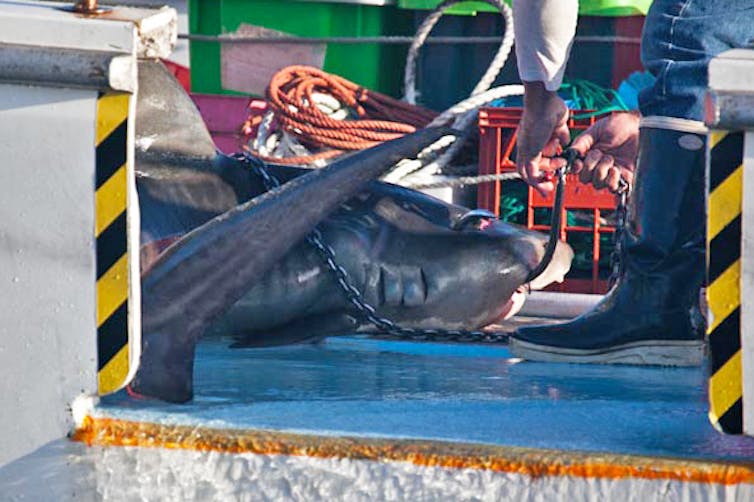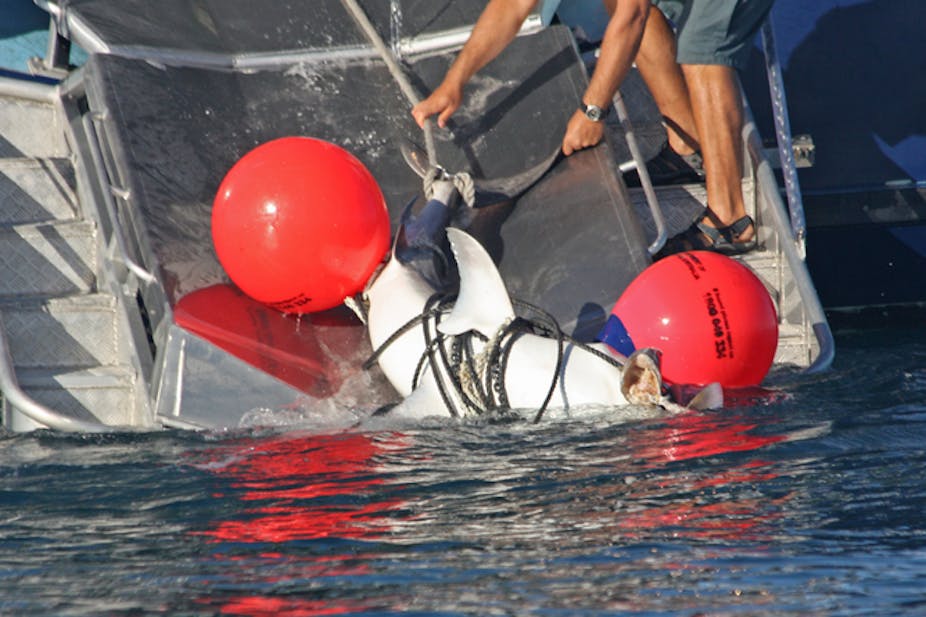As Western Australia’s Environmental Protection Authority and the federal environment minister Greg Hunt mull the question of whether to let the state government resume its controversial shark cull next summer, it’s worth asking what lessons we gleaned from the original round of culling.
The 13-week deployment of baited drum lines off popular beaches in Perth and the South West caught 172 sharks, all of which are of conservation concern. Of these, 35 (23%) and 5 (3%) were destroyed as they either exceeded 3 metres or were near death. A further 24 (14%) were dead on the line, and 104 (60%) were either “released alive” or managed to free themselves.
It would be comforting to think that these animals did not die entirely in vain, and that the program would at least have taught us something about the risks that sharks pose to humans. Sadly, we are no better informed now than we were before the drum lines went into the water.
Here are the things we learned – and, most crucially, the things we didn’t.
The “risky” sharks were not caught…
No white sharks – clearly the main target species – were caught on the drum lines. This may be partly because white sharks appear to be more common in the winter, a pattern mirrored in Queensland. It may also be that white sharks are simply difficult to catch on drum lines – in Queensland, on average only five white sharks are caught each year by the 178 drum lines deployed in areas where these sharks are most often captured. Of these, typically only one exceeds the 3-metre size threshold used in WA.
White sharks are clearly present, indeed, an animal was observed shortly after drum lines were removed. But they are not being caught, suggesting that drum lines are ineffective. And that’s before we even consider the question of whether catching them is worthwhile from a safety perspective.

We also learned, ironically, that there are probably more tiger sharks off Perth and the South West than we thought, given that they accounted for 163 of the 172 captured sharks. But tiger sharks clearly do not pose much of a risk to humans, because the last death attributed to a tiger shark in the region was in 1925. These animals were also probably here last year, and the year before, without causing any harm.
It is not enough simply to state that some captured tiger sharks were twice the size of a really tall AFL player as evidence that they pose a threat. Yes, tiger sharks have been implicated in incidents in other, typically more tropical regions. But we don’t know enough about their behaviour in southern WA waters to understand why they seem to coexist more easily with humans here.
… but plenty of other animals were
Despite the use of large hooks in an attempt to minimise the capture of non-target species and undersized sharks, 74% of the animals captured were either the wrong species or undersized. This is worrying, because many of them are likely to have died from their injuries after being released. Pictures released by independent observers and matched to catch data suggest that animals officially recorded as “released/alive” did not necessarily survive given either their moribund state or the severity of their wounds.
Size matters…
Tiger sharks reach reproductive maturity at a size of around 3 metres. This means that the 45 animals larger than this size that were deliberately destroyed or found dead on the line were probably just beginning to breed.
Removing large breeders from shark populations is a problem: they have good genes, as they are the ones that made it through the lottery that is life in the oceans for young animals. Indeed, protecting big breeders has been a key strategy for the WA Department of Fisheries in managing commercially overexploited sharks.

But it’s not just the current breeders: of the 117 smaller tiger sharks that were released, many will have died. This loss of future reproduction will damage the population’s recovery.
… and so does sex
Female sharks greatly outnumbered males in the catch. Overall, 2.9 female sharks were caught for every male. Of those longer than 3 metres, four times as many females were caught as males. This is a stark contrast to a previous studyon tiger sharks in Shark Bay, in WA’s Gascoyne region. There, sampling found a 1:1 ratio of females to males over 3 metres. It’s also much higher than the sex ratio of tiger sharks in Queensland, where 1.5 females were generally caught per male overall, and 2.5 females per male among those over 3 metres.
There are two possible explanations. Either the waters off southern WA are home to a community of tiger sharks dominated by females (suggesting the region is particularly important to them), or the drum lines selectively target females.
Either way, this sex skew is bad news for shark populations. I’m not suggesting that males are unimportant. But given that female tiger sharks typically reproduce only once every two years, with relatively small litters, and that larger females have greater reproductive output, these big, old, fat females are to be valued.

What we didn’t learn
Human risk can be minimised by learning more about the movements of sharks. But the conventional tags used in this program do not provide this information; all they do is identify an animal in the event that it is recaptured. This is in contrast to acoustic and satellite tagging research on tiger sharks and white sharks, and surveillance programs such as Shark Spotters that collectively build knowledge on where sharks go, and when.
Tissue samples can also provide valuable clues, by revealing how genetically diverse (and therefore big) the populations are, and where sharks have been and what they are eating based on their chemical isotope signatures. Yet these samples were apparently not collected.
Photo identification can also generate estimates of population status.
Importantly, we don’t have to kill sharks to obtain knowledge on movements, population size and structure, and feeding behaviour. All of this information, directly relevant to improving safety, can be gathered through non-lethal shark shark hazard mitigation programs.
What a shame we learned so little that will help us reduce the risk to humans in WA’s oceans. Meanwhile, what we did learn suggests that the cull poses very real risks to sharks.

